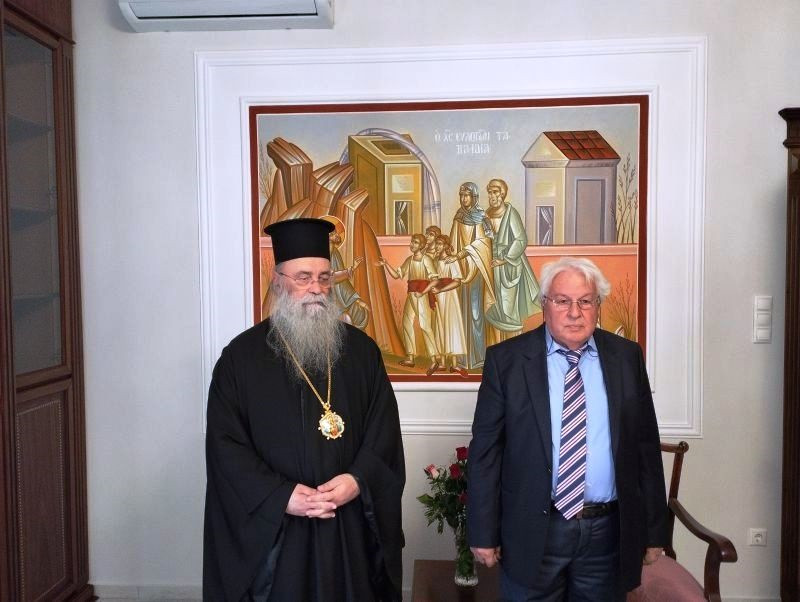The victims of the massacre by the Ottomans were a total of 202, of which 24 hieromonks, 3 deacons, 145 monks and 30 pilgrims of the monastery.
Some priceless manuscripts of the holy monastery stolen for centuries Panagia Eikosifinissa Pangaiou, who have recently returned, now reveal the rich history of the monastery, practically confirming the oral testimonies that existed until today about a series of events that marked the monastery during its long and turbulent history.
Thus, the oral testimony to date for a great massacre of the 16th century by Ottoman conquerors which resulted in the tragic death of all the monks, is also confirmed in writing in the last manuscripts that came back into the ownership of the monastery about a year ago.
That’s what he announced the Metropolitan Dorotheos of Drama during a press conference he gave with the professor emeritus of the Democritus University of Thrace and a systematic researcher of the manuscripts and the history of the holy monastery of Panagia Eikosifoinissa, George Papazoglou.
From a New York auction house back to Drama
In October 2023, the Metropolitan of Laodicea, Theodoritos, as the representative of the Ecumenical Patriarch in Athens, handed over to the Metropolitan of Drama three stolen manuscripts of the holy monastery of Eikosifoinissa dating from the 16th century. Through the mediation of the archdiocese of America, the above manuscripts came into the legal possession of the Ecumenical Patriarchate from the collection of the Swann Auction Galleries of New York.
After their theft from the monastery in 1917, they ended up in America from where they were sold in 2008 to a Chicago collector, who however returned them when he found their ownership to be legally and ethically questionable.
The manuscripts remained for years in the particular auction house and after it was established that they were stolen from the Patriarchal and Crucifixion Monastery of Panagia Eikosifonissa, it was decided by those in charge to take legal action towards the Ecumenical Patriarchate, so that they could be returned to the rightful owner.
The great secret that the manuscripts hid
In one of these manuscripts marked X 8, Mr. Papazoglou found a note and text related to the massacre of the monks of Eikosifonissa by the Ottomans in the year 1507.
Mr. Dorotheos underlined that “until today we knew of the existence of a manuscript only from the testimonies of scholars of the history of the monastery where it was mentioned that the slaughtered monks were 172”. However, with the discovery of the paper manuscript, “we have all the names of the slaughtered monks, who met a tragic death on August 25, 1507 and who were commemorated in the so-called Parrisia”.
The handwritten note states: “In 1507, a great and terrible calamity came to the holy monastery and they killed the monks and sacked the monastery as well, in the month of August (25) in (diktionos) i”. Then, under the heading “These are the monks,” there is a list of the slaughtered monks and others. In the margin (oa) of sheet 31 there is also confirmation of the continuity of the list of slaughtered monks with the writing of those years and the designation: “The unjustly killed”.
It should be noted that the victims of the massacre were a total of 202, of which 24 priests, 3 deacons, 145 monks and 30 pilgrims of the monastery.
From the study of the specific manuscript by Mr. Papazoglou, it was also established that the paper was of a western type, contemporary with the events and in various sheets, while it seems to have been produced at that time. “Therefore, the monk – author of the note and the list of the massacred is a contemporary and knows the events firsthand”, underlines the Metropolitan of Drama.
Professor Papazoglou, during the press conference, also referred to the long and difficult journey of the specific manuscripts before they returned to the holy monastery. Finally, the metropolitan of Drama described the whole event as a great blessing of the Virgin Mary and pointed out that he will continue, under the pious guidance of the Ecumenical Patriarch Bartholomew, the struggle to return the remaining manuscripts and relics to the holy monastery.
Source: Skai
I have worked as a journalist for over 10 years, and my work has been featured on many different news websites. I am also an author, and my work has been published in several books. I specialize in opinion writing, and I often write about current events and controversial topics. I am a very well-rounded writer, and I have a lot of experience in different areas of journalism. I am a very hard worker, and I am always willing to put in the extra effort to get the job done.












